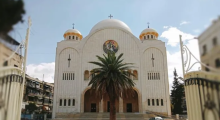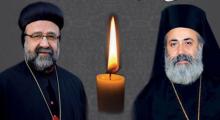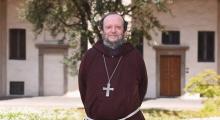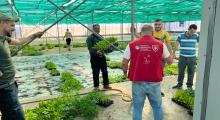Issued by the Catholic Center for Studies and Media - Jordan. Editor-in-chief Fr. Rif'at Bader - موقع أبونا abouna.org

Cardinal Philippe Barbarin of Lyon accompanied the Chaldean Patriarch Raphael Sako on his first visit to Mosul, which has just been taken from ISIS.
Its rotund form is as elegant as ever but nothing remains of its rich décor.
“They took all the marble plaques,” laments Archbishop Raphael Sako as he enters the Holy Spirit church in Mosul.
Emotional, the patriarch of the Chaldean church has just returned for the second time to the great Iraqi city that was liberated from ISIS control only a few weeks ago.
On this occasion, he is accompanied by Cardinal Philippe Barbarin of Lyon, who has raised awareness in his diocese regarding the situation of Eastern Christians and twinned his diocese with Mosul.
The Virgin of Fourvière
On his first pastoral visit to Iraq, Cardinal Barbarin insisted on visiting Mosul with the patriarch to symbolically set up a small statue of the Virgin Mary in gilded metal, a copy of the one that dominates the Fourvière basilica in Lyon, “as a sign of Hope".
The statue had been ready in Erbil, in neighboring Kurdistan since 2014, awaiting the liberation of the Iraqi city.
Feet bare in the devastated great nave, His Beatitude Louis Sako, and several Chaldean priests intone an Arabic chant.
The French delegation accompanies with a Hail Mary.
Their serious voices resound under the cupola, which has lost all its stained glass windows.
ISIS militia ripped out the decorative forged iron to resell it.
The visitors put back their shoes and leave by car, casting an eye on several more of the 25 churches in Mosul, which hosted a significant Christian community before the war.
ISIS drove them all out.
The ancient city of Nineveh
In the west, the city is not yet fully secure. The delegation, therefore, remains on the east bank of the Tigris in the neighborhoods still known as Nineveh, the name of the ancient city.
“If we are able to reach the city center,” explains the Patriarch to Cardinal Barbarin, “we will see churches there from the tenth and even the fifth century because Christianity is very ancient in this Mesopotamian region of the world.”
However, judging by what we have seen in Nineveh, ISIS appears to have spared nothing. The disastrous situation is the same in every church, including the Assyrian Martyrs church, the Syriac Catholic Annunciation church, and the Syriac Orthodox Saint Ephrem cathedral.
Everything has been broken and vandalized. Graffiti such as “ISIS will reign for a thousand years” remain daubed on the walls.
In the Chaldean St Paul’s church, the tomb of Archbishop Rahho, who was abducted in 2008 and found dead, has been trashed, moving to tears his friend Bishop Marc Stenger of Troyes, president of Pax Christi and a member of the French delegation.
In Mosul, hectic, noisy daily life has started to budge along the roads. However, evidence of fighting and bombardments is everywhere and very few strategic buildings that were hit have been cleared.
Churches targeted
What is striking, however, is that in the quarters where the churches are located, the houses that surround them have been left intact and are covered with bougainvillea.
The destruction was clearly systematic and targeted.
For the moment, all the Christians of Mosul have fled and still hesitate to return to a city where they no longer feel welcome.
The Iraqi government and the various churches will have much to do to persuade them that they still have a place here.
“We need to persevere,” said Patriarch Sako climbing over the rubble mixed with remains of ammunition that soils the courtyard of St Paul’s church.
“Evil has no future,” he concludes.







